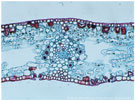Metabolism
Part of the The World's Largest Dinosaurs exhibition.
Part of the The World's Largest Dinosaurs exhibition.
How much food did these giants need? That depends on how much energy they used. Scientists are trying to figure out if sauropods had metabolisms more like modern mammals and birds, which need a lot of energy to sustain themselves, or like snakes, lizards and turtles, which use relatively little energy.
At hatching, Mamenchisaurus weighed about what you did as a baby. Getting from there to an animal upwards of 60 feet is a huge task, and there's only one way to do it. Eat a lot, so you can grow very fast. But how much is "a lot"? And what kind of metabolism allows such rapid growth?
Huge animals like Mamenchisaurus had to eat a lot to get big. They couldn't afford to be picky; the goal was quantity, quantity, quantity. This cube holds the amount of plant matter experts think Mamenchisaurus would have eaten every day. It weighs a little over 1,000 pounds.

A rigid wall, clearly visible in cells at the top and bottom of this cut through a ginkgo leaf, surrounds virtually all plant cells. Composed of the compound cellulose, it makes parts of plants tough to digest. But there was plenty of room in the sauropod gut for up to two weeks' worth of food to be processed, allowing time for microbes to break down the cell walls.
Because sauropods skipped chewing, they could take in the vast amounts of food needed to power their huge bodies. And there was plenty of room inside for all that food. As this diagram shows, when the length and width of an object--a cube or a sauropod dinosaur--doubles, the space inside increases eight times.